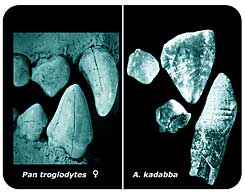John Noble Wilford New York Times

Dental remains of Ardipithecus cadaba. A separate species and not a subspecies. Photo: Dr. Tim White
Direct link to this page: https://www.hayadan.org.il/ethiopiafossil.html
Another species has recently joined the family tree of humanity's ancestors. He lived in the area where Ethiopia is today 5.8-5.5 million years ago - long before Homo erectus, Australopithecus afarensis and other distant fleshy remains of modern man.
The ancestor may be one of the first hominids to appear after the evolutionary split between chimpanzees and human ancestors, 8-6 million years ago. The point in time at which the fateful split occurred has been determined by molecular biology researchers, and in recent years "fossil hunters" have found remains of those ancient hominids.
Remains of the hominid were discovered a few years ago and three years ago researchers described the characteristics of its bones and teeth. Paleoanthropologists have determined that it is a subspecies (that is, a species that is not completely different) of Hardypithecus ramidus, a hominid discovered in 1994, also in Ethiopia. He was named Ardipitcus Ramidus Cadaba.
However, last Friday, in an article published in the journal "Science", researchers report that after a careful study of the fossil remains of five individuals of Kadava, it becomes clear that the fossils are unique to the extent that it is necessary to consider them as a separate species, Ardipitcus Kadava, and not as a subspecies of Ardipitcus Ramidus. It is even possible that the Kadaba is the direct ancestor of the Heramidos. However, the researchers - Dr. Johannes Haile-Silasi from the Cleveland Museum of Nature, Dr. Gan Sawa from the University of Tokyo and Dr. Tim White from the University of California at Berkeley - add that the small number of skeletal bones they had in their possession makes it difficult to understand other characteristics of the Kadaba.
The Kadaba fossils were found in the Awash Valley, about 300 kilometers from Addis Ababa. Today it is an arid land, but in the time of the early hominids the land was covered with forests.
According to Dr. Haile-Silasi, the shape and wear patterns of six of the Kadaba's teeth were "extremely important for understanding how the dental system evolved from the ape-like ancestor of the human lineage to the early hominids." The teeth also helped researchers distinguish between the early and late species of Ardipithecus.
Other scientists who were aware of the study but did not participate in it agree, or tend to agree, with the researchers' conclusion, according to which Hardypithecus cadaba is a separate species from Hardypithecus ramidus. But they show skepticism regarding another hypothesis of the research team, according to which the Kadaba fossils and fossils of two other recently discovered early hominid species belong to a single hominid genus.
The other two hominid species are Sahlanthropus takadensis, which was discovered in Chad and is believed to be 7-6 million years old, and Aurorin tuganensis, which lived 6 million years ago in Kenya. These are two monkey-like creatures, whose size did not exceed that of the chimpanzee of today. Although the analysis of the remains of the hominids has not yet been completed, and is still a matter of debate, each of them has so far been classified as a separate species belonging to a separate genus.
However, Dr. Haile-Silasi and his colleagues write in their article, that "considering the limited data we have, it is possible that these remains are actually variations within the same genus." Dr. White, one of the most experienced paleoanthropologists in the world, emphasized this hypothesis in a telephone interview. "These early hominids are very, very similar," he said. "When we look at the three photographs, we are impressed by the many biological similarities and not by the differences between them."
However, in a commentary article accompanying the article in "Science", Dr. David Began, a paleontologist from the University of Toronto, challenged White's interpretation. According to him, it is unlikely that the three ancient hominids belong to one genus since there are impressive differences between them. However, Bagan added, "the paucity of the remains in our hands causes the raising of various hypotheses, the correctness of which cannot be proven with certainty."
The different hypotheses reflect two central theories about the shape of the hominid family tree. According to one theory, the tree looks like a ladder. According to the second, like a bush. More and more researchers, who find different species of hominids that lived in overlapping periods, adopt the discourse theory and claim that the hominids developed along a large number of evolutionary lines, in response to changing environmental conditions.
They know evolution - the rise of man
For the initial news on Yahoo's news site
https://www.hayadan.org.il/BuildaGate4/general2/data_card.php?Cat=~~~788628263~~~51&SiteName=hayadan
